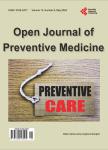Simple anthropometric measurements to predict dyslipidemias in Mexican school-age children: a cross-sectional study
作者机构:School of Natural SciencesUniversidad Autonoma de QueretaroQueretaroMexico Disease and Development Center for Chronic DiseasesQueretaroMexico.
出 版 物:《Open Journal of Preventive Medicine》 (预防医学期刊(英文))
年 卷 期:2011年第1卷第3期
页 面:171-181页
学科分类:1002[医学-临床医学] 100201[医学-内科学(含:心血管病、血液病、呼吸系病、消化系病、内分泌与代谢病、肾病、风湿病、传染病)] 10[医学]
基 金:Conacyt Mexico
主 题:Cardiovascular Risk Dyslipidemia Lipids Anthropometry and Children
摘 要:Objective: The purpose of this study was to identify the best predictors of dyslipidemias in Mexican obese children using different anthropometric and body composition measurements. Methods: In an observational, cross-sectional study, 905 children from 5 schools were measured for weight, height, waist and hip circumference, and triceps and subscapular skinfolds. A fasting blood sample was taken from a random sub-sample of 306 children to determine lipid profile. Abnormal total cholesterol, LDL, HDL, triglycerides, total cholesterol to HDL ratio, and LDL to HDL ratio, were determined. Logistic regressions and ROC analysis were carried out to determine the best anthropometric predictors of these risk factors. Results: Prevalence of elevated total cholesterol, triglycerides and LDL cholesterol was 14%, 56% and 58%, respectively. In logistic regressions, BMI and triceps skinfold had the highest odds ratios to predict elevated total cholesterol (1.05, 95%CI: 0.97 - 1.14;1.07, 1.01 - 1.13, respectively), triglycerides (1.19, 1.11 - 1.27;1.12, 1.08 - 1.17, respectively), LDL cholesterol (1.11, 1.04 - 1.18;1.09, 1.05 - 1.14, respectively), total cholesterol to HDL ratio (1.06, 1.00-1.14;1.07,1.03-1.12, respectively) and LDL to HDL ratio risk (1.08,1.01-1.15;1.07, 1.03-1.12, respectively). After BMI and triceps skinfold, subscapular skinfold also predicted dyslipidemias, except for low HDL;both skinfolds had a narrower odds ratio confidence interval than BMI. In ROC analysis, subscapular skinfold was the best predictor of elevated triglycerides with an AUC ≥ 0.7. Conclusion: Anthropometric measurements are not strongly associated with dyslipidemias in Mexican children. However, since triceps and subscapular skinfolds were better predictors than other anthropometry measures, they may be a simple way to predict dyslipidemias in Mexican children.



